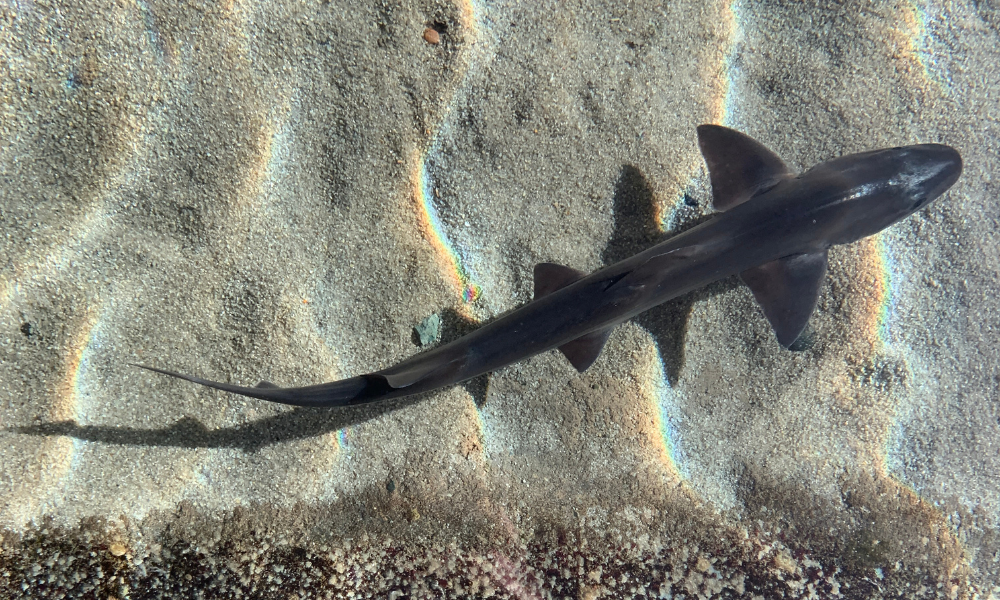Enter the fascinating world of sharks and rays!
Touch the velvety backs of friendly rays as they glide through the interactive touch pool. Then view leopard sharks, guitarfish, bat rays, and more in a 21,000-gallon exhibit with multiple underwater viewing areas.

Barred Sand Bass
Paralabrax nebulifer
The barred sand bass has a long body and squarish tail, with dark gray to greenish-gray coloring and vertical side bars. Its head features golden-brown spots and a downturned mouth, earning it the nickname “grump.” These fish inhabit the eastern Pacific coastal waters, from Santa Cruz, California, to Bahía Magdalena, Baja California, Mexico, usually in sandy areas near rocky reefs and kelp beds at shallow to moderate depths.
Bat Ray
Myliobatis californica
Bat rays are named for their distinctive flat bodies and wing-like fins. They have a protruding head, large eyes, and a long, whip-like tail with a poisonous spine, usually colored black or dark brown on top and white underneath. These rays inhabit the eastern Pacific Ocean, from Oregon to the Gulf of California and near the Galapagos Islands. They prefer shallow, sandy, or muddy areas, typically from the surface to about 150 feet, as well as rocky bottoms and kelp forests.


Diamond Ray
Dasyatis dipterura
Diamond rays are large, flat fish shaped like diamonds, with long, whip-like tails that feature a poisonous spine. Their coloration varies; many are dark on top, such as reddish-brown or olive gray, with white undersides to help them blend into the sandy ocean floor. They are found in the eastern Pacific Ocean, from southern California to northern Chile, as well as around the Galapagos and Hawaiian Islands. Diamond rays live near the ocean floor in sandy or muddy areas, often close to rocky reefs or kelp forests.
Garibaldi
Hypsypops rubicundus
The California state fish, garibaldis, can be found as far north as Monterey Bay, but are most common in the warmer waters of Southern California and the Channel Islands. They are named after Giuseppe Garibaldi, who famously wore bright red shirts. He went on to fight for the reunification of Italy, becoming a general and a national hero. When biologists discovered this red-orange fish that would aggressively defend its territory, they knew exactly what to name it! Garibaldis are highly territorial, primarily for reproduction and to protect their food and shelter. Males are especially territorial, preparing nests by cultivating a specific red algae and fiercely guarding them against predators and intruders to ensure the survival of their eggs.


Gray Smooth Hound Shark
Mustelus californicus
The Gray Smooth Hound Shark is a small, slender shark with a pointed snout and a lobed, asymmetrical tail fin. It has flat, grinding teeth for a diet of crustaceans and mollusks. Females grow up to 5 feet 4 inches, while males are smaller. Found in the eastern Pacific from northern California to the Gulf of California, these sharks live along continental shelves and in shallow waters of bays, rocky shores, and estuaries, often schooling with leopard sharks.
Horn Shark
Heterodontus francisci
The horn shark prefers shallow waters under 40 feet deep, hiding under ledges, in caves, or among kelp. It feeds on seafloor invertebrates like sea urchins and crabs, occasionally small fish. Females lay spiral egg cases in crevices, each containing one pup, which hatches in six to nine months. The shark’s front teeth are sharp for grasping prey, while its back teeth are flat for crushing shellfish. The ‘horn’ name comes from spines in front of each dorsal fin.


Leopard Shark
Triakis semifasciata
They are some of the most common sharks found along the coast of California. Named for their appearance, Leopard sharks arrive in San Diego in massive numbers during warm summer months, and have been observed to be mostly pregnant females! While here, they enjoy the warm, shallow, protected waters of the Matlahuayl State Marine Reserve in La Jolla, California. Leopard sharks are well-adapted to living near the ocean floor, spending most of their time a foot or so above the bottom. This is because they, like all sharks, lack a swim bladder, a sac-like organ that fish use to fine-tune their buoyancy. Instead, they store oil in their massive livers to counterbalance their own weight. They typically remain slightly less buoyant than the water around them, so they tend to sink when they are not swimming.
Round Ray
Urobatis halleri
Round stingrays have a circular, pancake-like shape when viewed from above. They possess a venomous spine on their tail, which they use for defense against predators. Known for their ability to bury themselves in the sand, round stingrays can effectively camouflage and wait for prey to swim by. Their diet primarily consists of small invertebrates and fish that they uncover while burrowing. These rays are typically found in sandy and muddy bottoms off beaches, as well as in bays, inlets, and channels, ranging from Humboldt Bay, California, to Panama.


Shovelnose Guitarfish
Urobatis halleri
The shovelnose guitarfish is found in shallow coastal waters ranging from central California to the Gulf of Mexico. It inhabits bays, sloughs, and estuaries, typically settling on soft sandy or muddy bottoms. This fish features pectoral fins that resemble the wing-like fins of rays, while its overall shape is similar to that of a shark. Its gray-black coloration helps it blend in with the sand, allowing it to hide from predators above. As bottom-dwelling predators, guitarfish primarily feed on crabs, clams, small fish, and other species.
Learn more about the marine life that resides in the Shark & Ray Experience!
We offer a Shark & Ray Presentation Wednesday through Sunday at 1:30 PM! Our educators will tell you all the important (and fun) facts about these slippery friends.